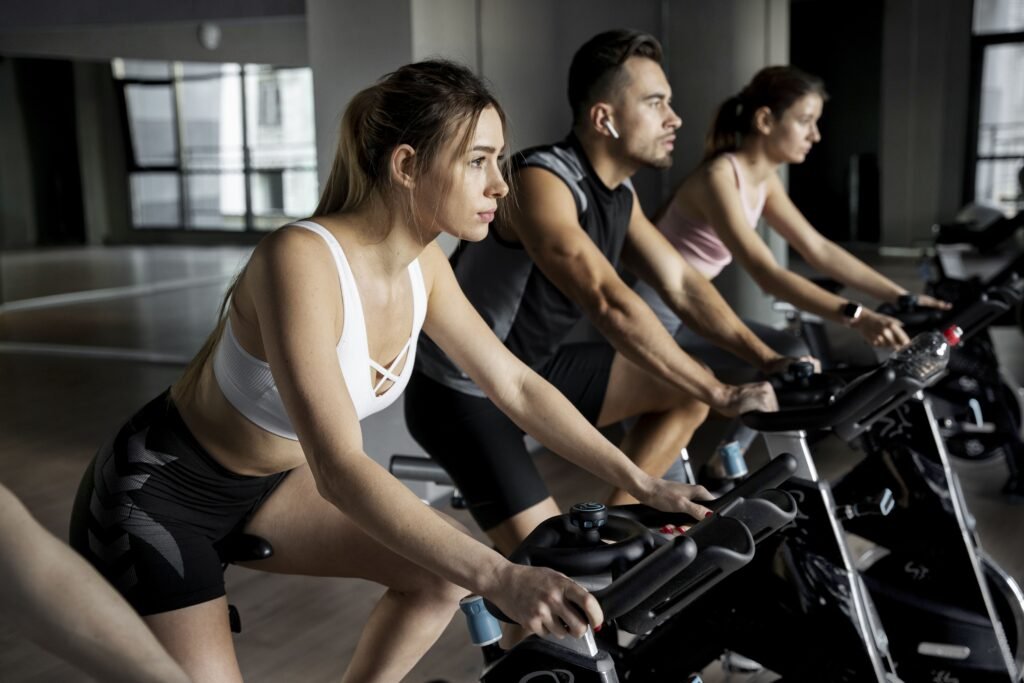The Best Fluffy Pancakes recipe you will fall in love with. Full of tips and tricks to help you make the best pancakes.
Best Indoor Cycling Tips for Beginners
Learn How Pro Indoor Cycling Tips and Settings Will Help You Reach Your Goal Faster and Improve Your Workout Performance

It’s 6:45 PM. We just got home, tossed our bags by the door, and jumped into padded shorts with dinner still on the stove. The fan hums. The bike squeaks. And we’re spinning — not because we have to, but because something in us wants to be better, fitter, stronger. We’ve all been there: figuring out the difference between smart trainers and wheel-on setups, fumbling with our first interval workout, wondering if it’s supposed to feel this awkward. Indoor cycling can feel intimidating at first ; confusing gear, sweaty discomfort, limited time. But we’re proof that it gets easier — and even fun — once you know what actually matters, which are our indoor cycling tips .
We created this guide for riders just like us, starting out with big goals and little time. If you’re ready to make the most of your minutes in the saddle, you’re in the right place. Let’s ride with the following tips.
Prioritize Your Fit — Indoors is Unforgiving
Indoor cycling doesn’t give you the luxury of natural movement that outdoor riding provides. Without terrain changes, coasting opportunities, or wind relief to break up your position, every millimeter of poor bike fit gets magnified. You’ll quickly discover hot spots on your feet, numbness in your hands, saddle discomfort, or inefficient power transfer that might go unnoticed on varied outdoor terrain. Getting your fit dialed in should be your first priority before diving into serious indoor training. This is one of the most crucial indoor cycling tips that beginners often overlook. Whether you invest in a professional bike fitting or use reliable fit apps, the key is ensuring your saddle height and reach are optimized for your body mechanics. This becomes even more critical if you’re using a dedicated indoor trainer or smart bike, as these setups can feel different from your outdoor position.
Hydration Strategy for Indoor Cycling: Mandatory, Not Optional
Hydration Strategy for Indoor Cycling: Mandatory, Not Optional
Indoor cycling causes you to sweat far more than outdoor rides — often 2 to 3 times more. That means dehydration becomes a real performance killer, affecting your heart rate, energy levels, and perceived effort. When your fluid balance is off, even your most efficient indoor cycling workouts will feel harder than they should.
To stay ahead, start pre-hydrating with electrolytes about 30 minutes before your ride. During workouts, aim to drink at least 750ml of water per hour — or more if you’re sweating heavily. For longer or more intense sessions, consider electrolyte-rich hydration mixes that contain sodium, magnesium, and potassium to replenish what you’re losing. This simple habit can make a big difference in your endurance, recovery, and how consistent your performance feels ride after ride.
Weekly Indoor Cycling Plan for Busy Riders: Avoid Burnout
One of the most common beginner mistakes is riding hard every single day. This leads to fatigue, plateauing, and eventually burnout — especially if you’re balancing training with a full-time schedule. Instead, adopt a structured weekly cycling routine that balances intensity and recovery.
A proven framework is either a polarized or pyramidal training model. Here’s a quick breakdown:
- 2 days of threshold or Sweet Spot training
- 1 high-intensity VO2 max day
- 1 longer Zone 2 ride (75–90 minutes)
- 1–2 low-intensity recovery or skills-based days
- 1 complete rest day
This structure promotes consistent progress while reducing injury risk. Check our Blog Post about Indoor Cycling Training for Busy Cyclists.
Track More Than Just Power: Focus on Cycling Load and Recovery
Power numbers are important, but they don’t tell the full story. To truly improve, indoor cyclists should also monitor training load, fatigue, sleep, and recovery markers. These metrics offer deeper insight into how your body responds — not just to workouts, but to stress, sleep, and hydration as well.
Use tools to track your TSS (Training Stress Score), resting heart rate, and HRV (heart rate variability, if available). Monitoring sleep quality and recovery trends also helps you know when to push and when to ease off. It’s not about training harder — it’s about training smarter. This holistic view keeps your progress steady and sustainable.
Final Thoughts: Master Indoor Cycling with These Essential Beginner Tips
Starting your indoor cycling journey doesn’t have to be overwhelming when you focus on the fundamentals that truly matter. These indoor cycling tips for beginners address the core challenges that separate successful riders from those who quit after a few frustrating sessions.
Your bike fit is non-negotiable. Unlike outdoor riding where natural terrain shifts mask fitting issues, indoor cycling exposes every misalignment. Poor saddle height, incorrect reach, or improper handlebar positioning will quickly turn into hot spots, numbness, and wasted power. Invest in professional fitting or take time to properly adjust your position before building training intensity.
Strategic hydration and cooling separate good sessions from great ones. Indoor environments trap heat and accelerate fluid loss, leading to performance drops that outdoor riders rarely experience. Set up a dual-fan cooling system while maintaining consistent electrolyte intake throughout your ride. This combination keeps your power output stable and training data reliable.
Structure beats intensity every time. Random hard efforts won’t build the fitness you’re chasing. Follow power-zone training principles, test your functional threshold power regularly, and balance high-intensity intervals with proper recovery days. Whether you follow established training protocols or create custom workouts, consistency within a structured plan delivers measurable progress.
These indoor cycling tips form the foundation for sustainable improvement. Master your environment, respect your body’s adaptation needs, and track meaningful metrics beyond just watts. With these fundamentals locked in, you’ll build lasting fitness gains regardless of weather, schedule constraints, or experience level. and always remember :
The guidance we once needed — now shared with you.






[…] how to avoid these early discomforts? Our full post on Best Indoor Cycling Tips for Beginners walks you through the […]
[…] What you eat before a spin class can make or break your ride — especially if you’re aiming to boost energy, support your muscles, and avoid hitting the wall halfway through. The key is to time your nutrition and choose foods that digest well and align with your workout intensity. For quick, accessible energy before a standard 30–60-minute session, go with simple carbs like bananas with honey, low-fiber toast with jam, or rice cakes with fruit spread. These options provide fast-digesting glucose that gets you moving without weighing you down. To support your muscles and recovery, add light protein sources to your pre-workout snack — like Greek yogurt with berries, a boiled egg with a banana, or a small whey shake with almond milk. These supply amino acids that reduce muscle breakdown and prep your body for post-workout repair. If you’re facing a longer or more intense session, add complex carbs and healthy fats to your fuel mix — overnight oats with chia and banana, a whole grain bagel with peanut butter, or sweet potato mash can deliver long-lasting energy without spikes or crashes. Caffeine, when used smartly, can also enhance focus, endurance, and power. Whether it’s a cup of black coffee, green tea, or a pre-workout supplement, caffeine helps delay fatigue, improve alertness, and increase performance — but always test your tolerance first. Ultimately, great spin class performance starts in the kitchen, not just on the bike. By dialing in your nutrition, you’ll unlock smoother rides, stronger intervals, and better recovery. Want more tips like these? Don’t miss our other posts: Indoor Cycling Training for Busy Cyclists and Best Indoor Cycling Tips for Beginners. […]
[…] and energy.Ready to dive deeper? Check out our other blog posts on what to eat before spin class, beginner tips, and calorie-burning workouts—they’ll help you get the most out of every ride and keep those […]
[…] can check other posts also to learn How to Plan your Training and some tips , or even Avoid some Mistakes! And always remember […]
[…] you’re new to the spin scene and feeling overwhelmed, our Best Indoor Cycling Tips for Beginners can make your journey smoother. It walks you through optimal setup, gear choices, posture, and […]